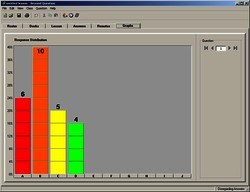Click for Concept-based Physics
I have always found that the teaching of Physics was much too centered on calculations rather than on the understanding of phenomena. It is not an unusual occurrence to find a student capable of doing complex exercises, but unable to answer a simple theoretical question. I would imagine that all Physics teachers sincerely aim to inculcate a firm theoretical understanding of the basic concepts of the science in their students rather than simply enabling them to unknowingly plug the right figures into formulas. This goal is now attainable through the use of clickers in Physics classes dealing with theory.

Clickers
Classes of Theory in Physics meet for two hours every second week. At these times, PowerPoint presentations containing multiple choice questions which can be solved with no calculations are introduced. The equations linked to the topic being discussed are also written on the board in front of the class uniquely for the purpose of helping the student to correctly deduce the reasoning required to answer the question. Here is an example of such a question:
A battleship simultaneously fires two cannonballs. Their initial velocities are not necessarily identical. The cannonballs follow the two trajectories indicated in the drawing. Which one will reach its target first?

Drawing of the cannonballs trajectories.
a) A
b) B
c) They reach their target simultaneously.
d) It depends on the initial velocities of the cannonballs.
Of course, given the initial velocity and launching angles, the answer to this question can be determined by calculating the time required for each cannonball to reach its target, but with a little thought, the answer can also be determined using only logic.
Students individually try to solve the question for about two or three minutes. Their responses are recorded using clickers.

Student’s responses
I use software called ‘Beyond Question,’ which was provided with my clickers, to see when all students have answered and how many students have selected each response. With these figures at hand, two options are possible after the results are announced:
- One can use peer tutoring. Students are asked to find a partner who has answered differently from themselves and try to justify their answer to the other student. This method works well, and students participate enthusiastically; however, the teacher cannot follow all the discussions, at best listening to those going on nearby. Once the discussion is over, students modify their responses if they’ve changed their minds.
- One can also have a class discussion and ask for a volunteer to openly explain the logic behind their reasoning in order to convince others. Five or six students can try to convince class members that their answer is correct and that the others are wrong. Throughout these discussions, students are at liberty to change their vote, and the teacher can instantly see the effect, positive or negligible, of each discussion on student opinion. Using this approach, the teacher can provide additional information, if required, when a particular student explanation is correct but not fully developed or explain why another response is incorrect. The problem with this tactic is that it is usually the same students who answer while others remain more or less passive.
It is not always necessary to have a discussion. If more than 80% of the class responded correctly, a rapid explanation for those in the minority will suffice before moving on. If practically no one got the right choice, on can provide futher information in the form of hints or directly ask those who did succeed to explain their reasoning. Occasionally, a student will tell you their answer is the result of a guess, but sometimes a very sophisticated correct explanation will emerge.
Obviously, student interest cannot be maintained without grades linked to the understanding of basic concepts. On my exams, fifteen theoretical questions appear, counting for two points each. Students are aware that this type of question will be on the test and try hard to understand the reasoning that led to the correct response. If you want to see examples of theory questions (in French) used in the exams, they are available for the three Physics courses on the site – La physique à Mérici.
Have you done something similar in your courses on theory in Physics or in another subject? Share your ideas and comments with Profweb readers by using our Reader Response Feature.
In case you were wondering, it is Cannonball B that arrives first at its target!

